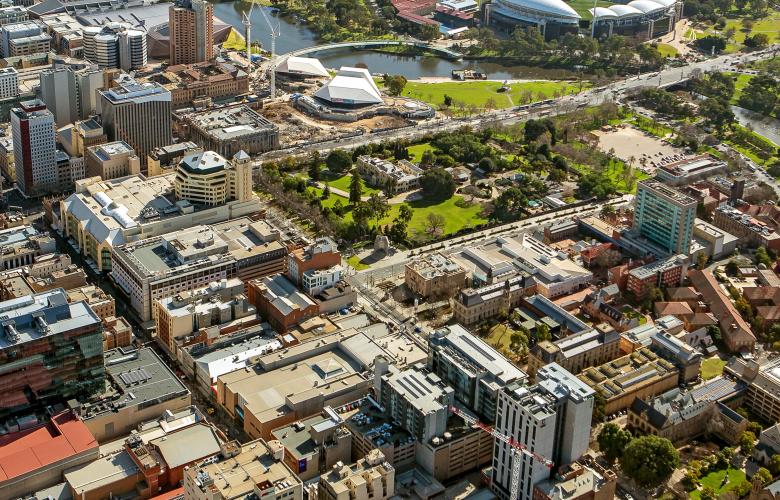Has Adelaide become the most interesting CBD office market?
Contact
Oct 18, 2019
Has Adelaide become the most interesting CBD office market?
All CBD office markets record positive net absorption over 3Q19, but new demand drivers in the Adelaide CBD capture attention, says JLL report.
All Australian CBD office markets showed positive net absorption of 37,900 square metres over 3Q19 and 119,800 square metres over the 12 months to September 2019, according to the latest JLL research.
The national CBD office market vacancy rate was 8.1 per cent in 3Q19 – a reduction of 1.0 percentage point over the year to 3Q19.
Yet, while business confidence remains patchy, Adelaide appears to be bucking the trend, with improved sentiment driven by the defence, aerospace, technology and health sectors.
At a glance:
- Adelaide sees increases in net absorption and a drop in vacancy rates driven by activity in the defence, aerospace, health and tech sectors
- Melbourne’s CBD prime grade vacancy rates tighten to 2.1 per cent in 3Q19 – the lowest level since 2008
- Vacancy rates remain high in Perth CBD (19.4 per cent) but the spread between prime (14.4 per cent) and secondary (27.2 per cent) remains wide, reflecting stronger occupier demand for prime grade assets
Boeing and BAE Systems recently expanded their footprint in the Adelaide CBD and net absorption totaled 7,100 square metres over 3Q19 with vacancy rates trending lower to 13.5 per cent with the prime grade sector moving back into single digit territory at 9.9 per cent.
According to the report, prime gross effective rents have also started to move higher and increased by 5.5 per cent over the 12 months to September 2019.
JLL Head of Research Australia Andrew Ballantyne said that even in the wake of the RBA’s decision to further ease monetary policy and support employment growth across Australia, some organisations remained reluctant to make long-term decisions until the economic outlook improved.
“Adelaide is one of the office markets where sentiment has improved significantly over the past 12 months,” Ballantyne said.
“Defence, aerospace, technology and health are all growth sectors of the Adelaide market and are having a positive impact on leasing enquiry and activity.”
The Sydney CBD recorded positive net absorption of 8,600 square metres in 3Q19 while vacancy increased marginally to 4.6 per cent as backfill space became available from relocation activity into a new development.
Overall, Sydney CBD sublease availability is sitting at 0.9 per cent of total stock – in line with the long-term average of 1.0 per cent of total stock.
JLL Head of Leasing Australia, Tim O’Connor described the Sydney CBD office market as a microcosm of the broader economy with expansion activity in the technology and flexible space sectors offset by some additional sublease space.
“However, we are seeing strong interest for the high-quality sublease space being marketed and a number of the options are expected to be absorbed relatively quickly,” O’Connor said.
The Melbourne CBD recorded 6,000 square metres of net absorption over the quarter and vacancy tightened to 3.7 per cent in 3Q19. The Melbourne CBD prime grade vacancy rate tightened to 2.1 per cent in 3Q19 – the lowest level since early 2008.
O’Connor said the low prime grade vacancy rate was a positive sign for the Melbourne CBD office market as the next wave of new developments reached completion in 2020 and 2021.
“Some of the concerns around backfill space availability are over-stated and we are already seeing healthy levels of enquiry on these assets,” he said.
Melbourne CBD rents continue to move higher with prime gross effective rents increasing by 4.8 per cent over the 12 months to September 2019.
The Brisbane CBD recorded 4,700 square metres of net absorption in 3Q19 and 23,400 square metres over the 12 months to September 2019. The headline vacancy rate compressed to 10.9 per cent in 3Q19 – the lowest level since 4Q12.
However, the report found that the improvement in the Brisbane CBD had not been at the expense of the Brisbane Near City market.
The Brisbane Near City recorded 31,600 square metres of net absorption over the past six months and a reduction in vacancy to 13.6 per cent in 3Q19.
Similar to the CBD, the Brisbane Near City prime grade vacancy rate (9.1 per cent) is significantly tighter than secondary grade (17.1 per cent).
“It is important to read behind the vacancy headlines in the Brisbane CBD,” Ballantyne said.
“We are seeing positive enquiry and activity for good quality assets and prime grade vacancy has now compressed to 6.8 per cent.”
The Perth CBD recorded net absorption of 7,700 square metres in 3Q19 and 39,800 square metres over the 12 months to September 2019. Vacancy remains elevated (19.4 per cent), but the spread between prime (14.4 per cent) and secondary (27.2 per cent) remains wide, reflecting stronger occupier demand for prime grade assets.
The Commonwealth of Australia has moved out of caretaker mode with stronger leasing enquiry and activity in the Canberra office market. Net absorption was 3,800 square metres over the quarter and vacancy tightened to 10.6 per cent in 3Q19. The A Grade sector of the market is significantly tighter with A Grade vacancy compressing to 6.0 per cent over the quarter.
O’Connor said that 2020 was shaping to be an interesting year for the office sector
“An uncertain economic outlook will influence decision-making, but a number of industry sectors are in expansionary mode,” he said.
“Infrastructure spending is a tailwind for the domestic economy and the potential to fast-track infrastructure spending would be positive for economic and white-collar employment growth.”
Similar to this:
Important Information:
Contact details:
Contact details:
Andrew Ballantyne
JLL Managing Director NSW and Head of Research - Australasia
Email
11319
8488
Andrew Ballantyne
Tim O'Connor
JLL Head of Leasing - Australia
02 9220 8680
Email
11319
11325
Tim O'Connor







